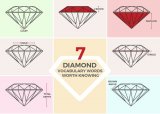It takes both art and innovation to bring a rough diamond to life and make it shine with the best fire, brilliance and scintillation. In my previous blogs about the 4C’s of Diamonds, I mentioned that the Cut of a diamond determines how well a polished diamond would sparkle due to internal light performance. In this blog, I will go over different parts of a polished diamond that make a Round Brilliant Cut.
Interesting Trivia: A Round Brilliant Cut diamond has 57 facets. If the culet of a diamond is also faceted, then the diamond would have 58 facets. Anything more or less means the diamond is not cut ideally.
1. Table: The table is the flat plane that sits on top of every Round Brilliant cut diamond. It is also the biggest single facet of the finished diamond. When defined and cut precisely, it helps bring out the most beautiful aspects of the diamond.
2. Crown: As the name suggests, it is the top part of the diamond. It starts from the outer edge of the table and ends at the upper end of the girdle. There are several facets cut into the crown, each perfectly balanced and identical to its neighbors.
3. Crown Angle: The angle formed by facets on the crown of the diamond with the imaginary plane of the girdle. The crown angle and the size of the table determine the amount of light that enters, reflects and refracts inside a diamond which directly affects the fire and brilliance of a polished diamond.
4. The Girdle: The outer edge or diameter of the diamond. It is the girdle that separates the top part of the diamond from the bottom. Since the girdle represent the highest diameter of a diamond, a slight variation in girdle thickness can greatly affect the carat weight of a diamond. Typically, all solitaires have faceted girdle while smaller diamonds may sometime have unpolished girdle.
5. Pavilion: This is the bottom part of the diamond – starting from the bottom edge of the girdle and reaching down to the very tip of the polished diamond. The pavilion angle can greatly affect the light performance of a diamond. If the pavilion is too deep or too shallow the diamond may look grayish.
6. Culet: It is a special minuscule facet added at the bottom of the pavilion to keep the tip of the diamond from getting damaged. In an Ideal cut diamond, the culet would be almost non-existent and undetectable by the naked, untrained eye.
7. Total Depth: In the simplest of terms, this is the height of the diamond as measured from the table to the culet.The above aspects give a diamond its shape and its allure. In addition to these, there are certain other important aspects that also need to be taken into consideration.
a. Symmetry: A diamond that is cut with perfect symmetry would yield the best light performance, brilliance and fire. It takes a highly skilled craftsman to cut and polish a perfectly symmetrical diamond as all the relevant facets must be identical and fully aligned
b. Polish: The smoothness of the diamond facets, small flat panels that are etched all over the surface of the diamond, greatly affects the amount of that enters inside a diamond. When a diamond is cut with perfect symmetry and polish, all the facets bring out the best fire, brilliance and scintillation.
![]()









Bablofil
Thanks, great article.
finance advice
What’s up to all, how is everything, I think every one is getting more from this web page, and your views are pleasant designed for new viewers.|